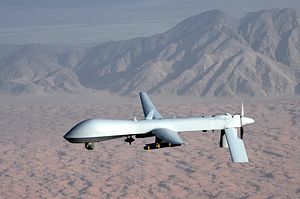Jacob Parakilas

This week, the Nobel Prizes are being announced. The Nobel Prizes, generally considered to be among the most prestigious international awards in the fields of science, literature, and peace, are named for Swedish industrialist Alfred Nobel, who made a number of important advancements in martial technology, including dynamite and smokeless gunpowder. Toward the end of his life, Nobel expressed the view that his efforts had been directed at making war so horrifying that the world would come together and ban it.
More than a century later, not only does war remain unbanned, but the way that martial technologies impact our imagination has fundamentally changed.
Nobel was not alone in his aspirations to end war by creating machines so powerful they would make it unthinkably brutal. Hiram Maxim, the inventor of the world’s first practical single-barrel machine gun, held similar views, only to see them proved horrifically wrong on the killing fields of World War I. And after the advent of nuclear weapons, influential physicists and political scientists advanced different elements of an argument that the unimaginable destruction wrought by nuclear weapons would make war obsolete, or at least marginalize it. War, as it does, transformed – conventional wars grew rarer while irregular wars did not – but did not disappear.
Other types of particularly brutal weapons – chemical and biological agents, for example – ended up hived off into their own category of shame rather than rendering war unthinkable. After the abundant use of chemical weapons in World War I, subsequent conflicts they have been largely (though not entirely) used as a weapon of terror or extermination against civilians – though this also reflects the degree to which military forces can be successfully hardened against such attacks.
Today, it seems as though the aspiration of weaponeering our way out of armed conflict has been left behind. Novel weapons and categories of weapons are being developed at a rapid clip, and yet there are few claims that tomorrow’s arms will make tomorrow’s wars too costly to consider.
Have we simply become more cynical about the characteristics of technology? That seems unlikely, given the continuing strain of techno-optimism embedded in Western discourses about societal progress (notwithstanding the actual impacts of novel technologies, which are more mixed).
Instead, something about the character of new weapons has changed. The advantages conferred by dynamite and the machine gun and nuclear weapons were of scale: a Maxim gun could generate more firepower than a platoon of riflemen; an artillery piece firing explosive shells could do far more damage than one firing solid shot; a single nuclear weapon could devastate a city. There is little to be gained by making more destructive weapons at this point – modern nuclear weapons, for example, are considerably less powerful in terms of sheer explosive force than their predecessors, because they can be delivered with enough accuracy to achieve their objectives at a lower force factor.
As a result – and to oversimplify somewhat – modern military technological advancement tends to be focused on increasing speed and accuracy rather than sheer destructive power. Whereas it was possible to imagine ever-more destructive weapons causing such outcry as to end war – inaccurate, as it turns out, but possible – a faster, more precise weapon seems to push the imagination in other directions.
We can see this in our cultural products. The first “Iron Man” film contained a two-minute sequence that neatly summed up the entire fantasy of technologically empowered, righteous warfare. As a besuited Tony Stark arrives in the midst of an Afghan village being overrun by Taliban surrogates, his AI instantly categorizes the people in sight as either “hostile” or “civilian,” and his shoulder-mounted antipersonnel guns wreck the former while leaving the latter utterly untouched. And when, a dozen films later, the Avengers are called to account for their collateral damage, the numbers of civilian casualties listed from their actions are laughably low.
Needless to say, this representation of exceptionally high accuracy and nearly zero tolerance for collateral damage is a fantasy. In the real Afghanistan, highly sophisticated coalition intelligence assets and airpower were brought to bear on civilian targets again and again, including in the war’s very final act.
And yet the fantasy persists. Instead of making war so terrible it can never be considered, we are now led to believe that technology will make war so fast and precise that we won’t even – to borrow the words of Dr. Strangelove’s General Buck Turgidson – get our hair mussed. Yet in reality, our wars continue to result in a huge expenditure of blood and treasure and little in the way of intended political progress.
Our view of technology’s impact on war may have moved on from Nobel’s, but it is still a long way from accurate.
No comments:
Post a Comment